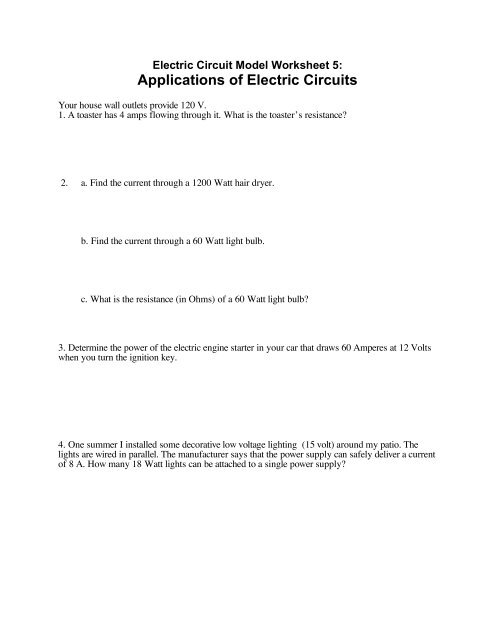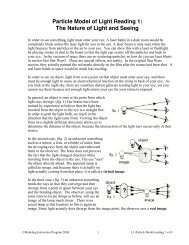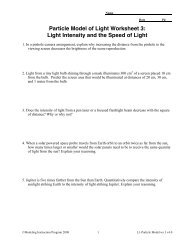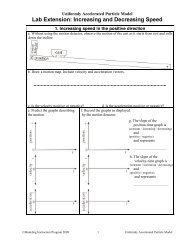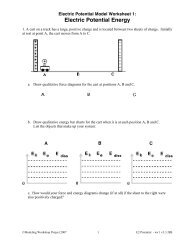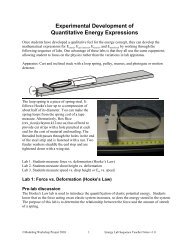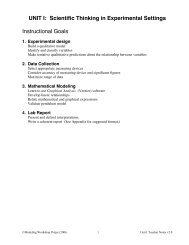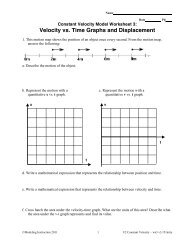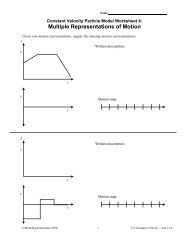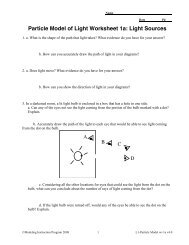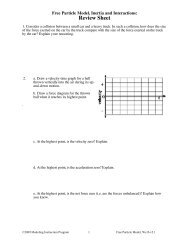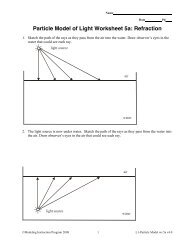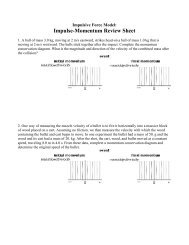Worksheet 5: Household Circuits - Modeling Physics
Worksheet 5: Household Circuits - Modeling Physics
Worksheet 5: Household Circuits - Modeling Physics
Create successful ePaper yourself
Turn your PDF publications into a flip-book with our unique Google optimized e-Paper software.
Electric Circuit Model <strong>Worksheet</strong> 5:<br />
Applications of Electric <strong>Circuits</strong><br />
Your house wall outlets provide 120 V.<br />
1. A toaster has 4 amps flowing through it. What is the toaster’s resistance<br />
2. a. Find the current through a 1200 Watt hair dryer.<br />
b. Find the current through a 60 Watt light bulb.<br />
c. What is the resistance (in Ohms) of a 60 Watt light bulb<br />
3. Determine the power of the electric engine starter in your car that draws 60 Amperes at 12 Volts<br />
when you turn the ignition key.<br />
4. One summer I installed some decorative low voltage lighting (15 volt) around my patio. The<br />
lights are wired in parallel. The manufacturer says that the power supply can safely deliver a current<br />
of 8 A. How many 18 Watt lights can be attached to a single power supply
5. Phones, answering machines, video cameras and other low voltage appliances can be plugged in<br />
with a thin wire that has a big lump at the plug-in end. The lump is called a transformer and<br />
"transforms" high voltage electricity into low voltage electricity. A common transformer has an<br />
output of 350 milliamperes at 10 volts. How much current does this transformer need from your<br />
120 Volt outlet (Assume that the power into the transformer equals the power out of the<br />
transformer.)<br />
6. Houses have current limiting devices such as fuses or circuit breakers to prevent too much<br />
current from flowing through the house wiring. A typical fuse lets no more than 15 Amps flow in a<br />
circuit. How many 100 Watt light bulbs could be safely lit on this circuit<br />
7. A standard house circuit can handle a flow of 20 Amperes of electrical current at 120 Volts.<br />
a. Determine the maximum wattage for the circuit.<br />
b. Determine how much electrical energy is "used" when 20 A at 120 V flows for an hour.<br />
c. Determine how much this hours' worth of energy would cost at 6 cents per kilowatt-hour.
8. Suppose you were using a shop vac to clean up the spillover from a flooded washing machine. If<br />
the shop vac flipped over and flooded the motor with water, how might the grounding wire save<br />
your life<br />
9. After blow-drying your hair, you set the dryer on the edge of the sink and it slips into the sink,<br />
full of water. How could the Ground Fault Circuit Interrupter save your life<br />
10. When designing a home electrical system, why are the outlets and lights for a single room NOT<br />
on a single circuit (What would happen if you overloaded the circuit)<br />
11. If a 60 W light bulb and a 100 W light bulb are connected in series to a 120 V outlet, they are<br />
not actually 60 W and 100 W bulbs. To show the difference:<br />
a. Draw a circuit diagram for the bulbs in parallel, label the resistances and voltage drops and<br />
determine the actual power of each bulb.<br />
b. Draw a circuit diagram for the bulbs in series, label the resistances and voltage drops and<br />
determine the actual power of each bulb.


